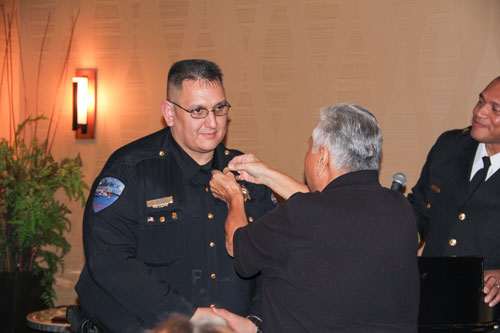Click the highlighted link below to download the March 25, 2015 Tulalip See-Yaht-Sub
March 25 2015 SYS
syəcəb
Click the highlighted link below to download the March 25, 2015 Tulalip See-Yaht-Sub

By Micheal Rios, Tulalip News
On Sunday, March 15, 2015 the Hibulb Rediscovery Program held a native gardening plant class to give Tulalip tribal members the opportunity to connect with their ancestral roots. This class was coordinated by Rediscovery Program staff members Inez Bill, Joy Lacy and Virginia Jones.
“We were very glad to see the large volume of interest. The class filled up very quickly,” says Virginia Jones. “We are thankful for the interest and wish we could offer it to more people. We are glad that people understand why we need to offer this class to our tribal members. We were anxious to see what kind of turn out we were going to have considering it was pouring down rain, but, despite the terrible weather, we were grateful to have a full class.
“The people got to hear advice about working with plants that has been picked up over the years from different teachers. The group went out and endured the rain. They learned how to harvest, clean, and process stinging nettles. They got to learn some of the uses for stinging nettles and what type of areas to look for them in. It was exciting to see. The class really came together and did the work. After the work was done they shared a light lunch.
“One of the important messages I hope everyone was able to take home is that it’s our responsibility to take care of these plants and the world they live in. It is just like fishing, hunting, clam digging, and berry picking. If we don’t protect their environments then there won’t be any places for us to harvest them from. If we overharvest, then there won’t be enough to sustain themselves. This is something that our people did for thousands of years. Now it is all being threatened by pollutants, new development areas, and people. I think a lot of the older generation can agree that the ‘woods’ just aren’t what they use to be. If we are going to go out and take these living things, then it is also our responsibility to protect them.
“Again, we thank everyone for their interest in the class. We are glad that there are so many people willing to reintroduce these plants back into their lives. These plants are able to provide their body and spirit with so much more than store bought foods.”
For more information about Hibulb Cultural Center events visit www.hibulbculturalcenter.org

By Brandi N. Montreuil, Tulalip News
TULALIP – “Honoring one honors us all” was the theme of the 2015 Tulalip Police Department Awards Banquet, held Wednesday, February 11, at the Tulalip Resort Casino. The banquet was held in recognition for officers and staff who have demonstrated exceptional professionalism and leadership within their positions as Tulalip Police officers or Tulalip Police staff members.
This year three officers, one staff member and a community member were highlighted for their outstanding work in the department and with the Tulalip community. While all officers and staff put 100 percent into serving the Tulalip community, Tulalip Chief of Police Carlos Echevarria said, “these officers’ and staff members’ work stood out.”
“With such a large staff it’s hard to choose just a select few. They all do such a great job throughout the year,” said Chief Echevarria.
Fish and Wildlife officer Clayton Horne was named Fish and Wildlife Officer of the Year for his service with the police department, while Lorelei Ranney was named Employee of the Year for her outstanding work and dedication in assisting officers and other department staff. The Chief’s Award was presented to Senior Officer Jeremy Mooring for his leadership, integrity, and willingness to go above and beyond the call of duty.

When presenting the award, Chief Echevarria had this to say about officer Mooring, “You have consistently performed your duties in an exemplary and professional manner.” Echevarria commended officer Mooring’s can-do attitude and praised his willingness to assist officers by taking on additional shifts when needed and helping to make safer road conditions for travelers in Tulalip.
The prestigious Officer of the Year award was presented to K-9 Officer Wolfy, whose watch ended on January 2, when she lost her battle with cancer. Wolfy’s handler and partner, officer M.C. Engen, received the award in Wolfy’s honor.
“Throughout their partnership, they have assisted in cases with the Tulalip PD Drug Task Force, FBI, DEA, and ATF agencies. We would like to commend you and your partner with the Officer of the Year award for the dedication and commitment you have provided to the department. Your devotion to the community, professionalism and commitment to duty reflected great credit upon yourself, the Tulalip Police Department and the Tulalip Tribes,” said Echevarria to officer Engen.
The department recognized community member Nate Hatch for their Honoring Our Own award, an annual award that is presented to community members who exhibit a commitment to leadership, trust, respect and service above self within the community.

“Nate Hatch, you have shown strong character, a can-do positive attitude, brilliant smile, sense of humor and most importantly, you have been an inspiration to the entire world following the events that occurred on October 24, 2014. Your bravery is second to none and we applaud you,” said Echevarria.
“Our year was cut short. As a tribal member, community member and chief of police it felt as though our year started on January 1 and ended on October 24. I literally cannot tell you what I did from October 24, until the end of the year; it is one large blur. As I look back, I can’t think of a better group of individuals in this police department and as a team that showed great courage, leadership, professionalism and the willingness to go above and beyond for the community, as I did in this group, that I would want to serve with,” said Chief Echevarria.
Wrapping up the banquet, all Tulalip officers and TPD staff members were presented a commemorative coin specially designed for them. Each coin symbolizes the dedication and commitment staff and officers have to keeping the Tulalip community safe.

Brandi N. Montreuil: 360-913-5402; bmontreuil@tulalipnews.com
Click the highlighted link below to download the March 18, 2015 Tulalip See-Yaht-Sub

By Micheal Rios, Tulalip News
The Tulalip Brand
When non-tribals think of the Tulalip Reservation, what do they think of? Surely some of the first things that would come to their minds are the Four Diamond rated Tulalip Resort Casino, the award winning fine dining restaurants therein, and the luxurious sanctuary that is the T Spa. For the upscale, fashion conscious individuals, they would assuredly think of the Seattle Premium Outlets that brings together the finest brands and cost-savings every day. Then there are those who would think of the essential shopping experiences provided by Quil Ceda Village stores, like Cabela’s and Home Depot.
It’s easy to understand why non-tribals, whether they be locals, visitors, long distance travelers or simply Washington State residents, would think of the exclusive experiences and premium services available to them on the Tulalip Reservation. First and foremost, the Tulalip Tribes has invested vast amounts of resources (money, time, manpower, more money) into creating the present-day image of Tulalip as a destination. From the early days of establishing the original Tulalip Casino in 1992, since rebranded as Quil Ceda Creek Casino in 2004, to the construction of the new Tulalip Bingo in 1999, to the inception of the ever expanding Quil Ceda Village in 2001, to the building of Tulalip Resort Casino in 2003 and followed by its accompanying hotel in 2008, the Tulalip Tribes has gone to great lengths and overcome many obstacles to create, develop, and brand itself as a tribal business leader.
Without question the planning, construction, and continued development of the Tulalip Tribes businesses and gaming enterprise has been first-rate. But those efforts, in large part, were aimed at crafting an enhanced image of the Tulalip Tribes from the outsider’s perspective and to create the market place for building a strong, loyal customer base that yields plenty of return business. Turn inward and we, the Tulalip tribal membership, can see that while the reservation along the I-5 corridor is unrecognizable compared to what it was fifteen to twenty years ago, the heart of the reservation remains relatively underdeveloped and deficient of the exclusive qualities that the Tribes is associated with externally. However, like the memories of the brush and forest that once occupied Quil Ceda Village, that will soon be a distant memory. The entire Tulalip Bay area is about to receive a major upgrade in image.
Creating change by building neighborhoods
The Tulalip Bay Work Force Housing Program, created by the Tulalip Housing department and approved by the Board of Directors, will makeover the heart of the reservation in the same way Quil Ceda Village changed the exterior boundaries of the reservation.
The Tulalip Bay Work Force Housing Program was implemented in early 2014. It is a three step process that will drastically change rural Tulalip, for the better. The first step of the process is taking back the land, that has for far too long been accommodating to non-Tulalips. More specifically, the land within the 1.7 square mile residential area around Tulalip Bay. Piggy-backing off the ideals that led to all the houses being demolished and removed from Mission Beach in 2013, all the non-Tulalip owned homes in the Tulalip Bay area are going to be removed in order to return the land to where it belongs, to Tulalip.
As the land leases expire, one by one each non-Tulalip house will be demolished, either by the residing home owner or by the Tulalip Tribes for a fee.
“New tribal mandates state that those folks living in the Tulalip Bay houses do not have the option to renew their lease because the Tulalip Tribes has made it its mission to take back the land,” says Tom Eadie, Tulalip Housing Authority Administration Manager. “Current Tulalip Bay tenants were told that back around 2003. The owner of the home, when their lease expires, has 90 days to remove their home. If they haven’t removed their home within the 90 days, then we remove their home and charge them the removal costs. At Mission Beach they removed their homes themselves. For Tulalip Bay, the opportunity to restore the beach-front would be available, potentially. We could have a several mile beach walk. It will be amazing, what we can do out there will be phenomenal.”
The second step of the Tulalip Bay Work Force Program is to build first-rate homes complete with top of the line appliances, immaculate fenced yards, and a house alarm. These will be beautiful homes, as evidenced by the first few that have been built already. Each featuring a multi-million dollar view overlooking stunning Tulalip Bay.
The second step also mandates that after the construction of the houses they will then be made available to Tulalip tribal members only, as either part of a home ownership program or as a rental. While most of the houses will be designated for home ownership, a fair share will be designated as rentals for those who are not in a position to buy a home. These newly built houses will become the homes of many Tulalip tribal members who would not otherwise have the opportunity to live on their reservation, and will help supplement the depleted housing market for our growing tribal membership.
“Everyone benefits from it in the long run. We can do a mix of rentals and home-ownership because we understand not everyone wants to own a home. Some people want to come and rent for a while and experience their reservation where their family is, and this gives them that opportunity,” explains Eadie. “You’re not going to find a 1,600-1,700 square feet house, especially on the water or near the water, anywhere else for the low prices we will be offering.
“You get to raise your kids in the heart of your reservation, and we’ll be continuing to develop that area: new sidewalks, light posts, we’re putting in a park, a really nice basketball court park right at Tulalip Bay. We’ll be selling these gorgeous houses within the $220ish price range. The prices are incredibly low when you look at comparable markets. There is no place in the state of Washington with that view and so close to a beach-front that even comes close to what we are selling them for. You’d double that price elsewhere, easy.”
The third and final step of the Tulalip Bay Work Force Housing Program involves the collaboration of both the Tulalip Housing department and the inherent responsibility of Tulalip tribal members. As the brand new houses are nearing completion and put on the market one by one, Tulalip tribal members, whether it’s for home ownership or to rent, must make themselves candidates in order to call a Tulalip Bay house their home. To have suitable, qualified Tulalip citizens and families stake their claim on the Tulalip Bay houses being built for them this means doing the necessities when it comes to preparing to buy or rent a new home on the Tulalip Reservation. Ways to be ready include meeting with a Housing department representative to discuss the qualifying considerations, and meeting with a 184 loan specialist and applying for a 184 loan if you want to become a Tulalip Bay home owner. Eadie explained that the standard operating procedures protect both you and the Tribes’ interests.
Remember that the Tulalip Bay Work Force Housing Program is still in the beginning stages of implementation and houses will be built and made available over the next several years. This means that if you don’t qualify to rent or purchase a Tulalip Bay home right now, that will not prevent you from renting or purchasing one of the many Tulalip Bay homes coming in the near future. Start on the path to becoming a qualified Tulalip Bay home owner or renter now. Start rebuilding your credit now. Start saving money for down payments and first/last month’s rent now. If you want to become a member of what will surely become a thriving Tulalip Bay neighborhood, then now is the time to start investing in that future.
Contact Micheal Rios at mrios@tulaliptribes-nsn.gov
Diabetes Day Tuesday, March 17, 9am – 3pm
Karen I. Fryberg Tulalip Health Clinic is working together with Puget Sound Kidney Center to offer a day of actives, such as crafts and nature walks, and information about nutrition and kidney health, along with a snack/cooking table with recipes.
There will be a light breakfast and a healthy salmon lunch for participants.
By Micheal Rios, Tulalip News
The Hibulb Cultural Center and Natural History Preserve’s Rediscovery Program is offering Tulalip tribal members an exciting new class to reconnect with their traditional culture. The class is part of a series of classes entitled ‘Native Plants and Medicinal Herbs’ that will be ongoing during the traditional harvesting season, early spring to late fall. The series of classes will focus on teaching tribal members how to collect, garden, harvest, and process native plants and herbs that are indigenous to the Tulalip region. The first of a full series of native plant gardening classes will take place Sunday, March 15, starting promptly at 9:00 a.m. and ending at 4:00 p.m., at the Center’s facility classroom.
“Our plants are our medicine. They nourish our bodies and feed our spirit,” says Inez Bill, Rediscovery Coordinator. “We want to see our people gardening and harvesting the plants and herbs that our people have used historically. So we are starting this brand new series of classes that will help pass on the values and teachings of our ancestors. Hopefully, by taking the classes, our people will begin to use these plants at their homes and grow them in their gardens for their own use.”
Over the past four years, the Rediscovery Program has hosted its ‘Gardening Together as Families’ classes that emphasized teaching our tribal membership how to grow their own organic vegetable gardens. The Rediscovery Program staff think that the time is right to shift from a general theme of organic vegetables to one that specifically tailors to the traditional gardening customs of our Tulalip ancestors. By reintroducing the Tulalip people to native plants and herbs that were once used by our ancestors for generations.
“We’ve been doing the ‘Gardening Together as Families’ classes for four years now. That was an opportunity for people to come get hands-on experience growing their own organic vegetables. Now, we are able to shift the theme of our gardening classes to accommodate the needs of our people,” explains Rediscovery staff member Virginia Jones. “We want to give the people an opportunity to learn about the uses of Tulalip native plants and to grow them at their own homes.”
Throughout this new series of native plant gardening classes, there will be a primary focus of working with and getting familiar with the many uses of five major native plants; the stinging nettle, fireweed, giant horsetail, the Nootka Rose, and mountain huckleberry. There will be other native plants worked with as well, to supplement the uses and knowledge that come from working with the five major native plants.
“These plants we will be working with are all traditional food sources. They are something that are ancestors would have had, and so we are really fortunate to have them still available to us,” says Jones. “Today these foods are no longer a part of our everyday diets. We are trying to reintroduce these native plants back into the diets of our people. We want to reach our people on that level because these plants were used as foods that healed us and kept our bodies full of all different types of nutrients that our bodies needed.”
To participate in the first class in this new series, to be held March 15, the Rediscovery Program staff ask that you please RSVP ahead of time by calling Virginia Jones at (360) 716-2635 and leave a brief message with your name and how many family members will be attending with you. The initial class will be accepting 20 tribal member participants, so RSVP your spot as soon as possible.
Also, all those who will be participating in the native plant gardening class should remember to bring garden gloves and paper bags.
“Working with native plants is our culture,” says Bill. “It’s a delicate balance of going out and being with nature, gathering plants in prayer and working with them in a respectful way. We are one with nature at this time.”
Contact: Micheal Rios, mrios@tulaliptribes-nsn.gov
Click the highlighted link below to download the March 11, 2015 Tulalip See-Yaht-Sub

By Brandi N. Montreuil, Tulalip News
TULALIP – You may have noticed that the Tulalip Police Department vehicles look a little different lately, in fact, it’s because they are. The department has recently added 15 new patrol vehicles. The new patrol vehicles were purchased using the 2013 COPS grant from the U.S. Department of Justice.
Nearly $800,000 was awarded to TPD to replace 15 patrol vehicles with no cost match required by the Tribe. The new vehicles will replace older patrol cars that have accumulated over 100,000 miles and considered a safety hazard for the officer and the community, in addition to being a burden on the department’s budget.
According to TPD, the department’s officers “respond to an average of 22,000 calls for service each year, make thousands of traffic stops and

average over 6,600 tribal housing checks per year.” Which according to the department has put a lot of wear and tear on the older patrol cars.
The new 2014 Ford SUVs have been outfitted according to the department’s needs and are replacing the older Dodge Charger models the department has been using. Updated graphics have also been added to the new patrol vehicles. The department’s new slogan, Trust Pride Dedication is featured on the back of each patrol car.
“These vehicles are literally the police officers’ office. Every thing they need is in the vehicle. Having an aging fleet can cause the cost to maintain them skyrocket. The cost to maintain these vehicles comes out of the department’s budget. Having this new fleet ensures the community reliability and safety. New vehicles are safe for the officers and the community,” said Carlos Echevarria, Tulalip Chief of Police.
Brandi N. Montreuil: 360-913-5402; bmontreuil@tulalipnews.com